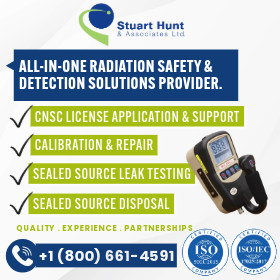Radon in the Workplace – Are You Protected?

Background
With national awareness campaigns and a dedicated Radon Action Month each November, it’s safe to say that an increasing number of people in Canada are aware of radon gas. Yet, how often does that knowledge translate into action?
Last year, in a two-part series (“Annual Dose Contributions of Typical Indoor Radon Levels,” Part 1 and Part 2), we explored the contribution of various indoor radon levels to one’s annual effective dose. We discovered that, in many cases, these contributions were far higher than have generally been assumed. Indeed, according to the Canadian Guidelines for the Management of Naturally Occurring Radioactive Materials (NORM), many homes in Canada would require NORM management were they to be classified as workplaces.
In this article (and the one to follow), we shift our focus to the workplace.
Radon in the workplace
Every day, radiation protection professionals apply their knowledge and training to protect workers from radiation exposure in the workplace. But what about radon?
While radiation in various forms has important applications in health science, we know general exposure to elevated levels of radon radiation is linked to increased risk of lung cancer. For radiation protection professionals, exposure to radon gas in the workplace may well be a case of the shoemaker’s children going barefoot. [1]
Invisible, with no taste or smell, it’s easy to forget about radon or write it off as background radiation. However, with inexpensive testing options and a range of radon mitigation solutions available, there’s no reason not to address radon head on. In fact, in our communication with provincial labour ministries, the Canadian Association of Radon Scientists and Technologists (CARST) have determined that radon clearly falls under the health and safety section of legislation to minimize hazards. In fact, the Ontario Ministry of Labour, Immigration, Training and Skills Development have adopted the Canadian Guidelines for the Management of NORM into their Occupational Health and Safety Act. [2] Employers therefore have a duty to test for radon to protect their workers’ health.
What else does radon in workplaces look like in Canada? In 2007, Health Canada offered free tests to all Federal government workspaces to help federal employers and building managers test their workspaces and address the need for remediation, should it be necessary. By August 2020, 21,665 buildings had been tested—3.6% tested above 200 Bq/m3 and 92 of those buildings tested over 600 Bq/m3.
Table 1: Canadian Guidelines for the Management of Naturally Occurring Radioactive Materials (NORM)
| Average annual concentration (Bq/m3) | NORM program classification |
| 800 to 3,000 | Radiation protection management |
| 200 to 800 | NORM management program |
| Background to 200 | Unrestricted |
Source: Canadian Guidelines for the Management of Naturally Occurring Radioactive Materials (NORM), Table 4.1: Radon and NORM Program Classifications, page 21.
The Government of Alberta and the Government of Yukon have also taken the initiative to test their workplaces. In 2017, Alberta’s Ministry of Infrastructure undertook an initiative to test all their workplaces, with a priority on testing schools. Alberta Infrastructure also introduced requirements for new construction to include prevention measures in all their new buildings.
The BC Lung Association (BCLung) published a report, Radon in BC: Employers’ Duties, Worker Strategies, and WorkSafeBC Policies, which includes a table of radon surveys completed in BC workplaces.
Although there isn’t accessible information about widespread testing in workplaces in other provinces, we know initiatives such as testing schools and social housing have been completed in various provinces.
For private employers, it’s generally impossible to know what actions have been taken. CARST has developed a one-page resource aimed at employers, directing them to other helpful resources to help raise radon awareness or communicate with their employees throughout the radon testing process.
Has your workplace been tested for radon?
We invite you to complete a short survey and enter to win a digital radon monitor (for homeowners). The results of the survey will be presented in a follow-up article.
[1] Proverbial saying meaning the family of a skilled or knowledgeable person is often the last to benefit from their expertise. (Oxford Reference)
[2] For more information, see Radon in the Workplace.
Résumé
Le radon en milieu de travail – Êtes-vous protégé?
L’année dernière, Erin Curry, la directrice régionale de l’Association canadienne des scientifiques et des technologues en radon (ACSTR), a examiné la contribution de diverses concentrations de radon à l’intérieur à la dose annuelle efficace dans une série de deux articles du Bulletin. Dans une nouvelle série qui commence dans cette édition, elle tourne son attention vers le radon en milieu de travail. Selon elle, même si nous savons que l’exposition à des concentrations élevées de radon est liée à un risque accru de cancer des poumons, pour les professionnels de la radioprotection, l’exposition au radon au travail pourrait bien être un cas de cordonnier mal chaussé.
 Erin Curry
Erin Curry
Erin is a mechanical engineer who previously ran her own building inspection and radon measurement firm. She is currently the regional director of the Canadian Association of Radon Scientists and Technologists (CARST). She also serves as project lead for the Take Action on Radon project. Erin brings a wealth of knowledge and practical experience to support CARST members. Based near Montreal, QC, Erin is the French-speaking contact for all CARST initiatives.
Do you want to read more articles like this?
The Bulletin is published by the Canadian Radiation Protection Association (CRPA). It’s a must-read publication for radiation protection professionals in Canada. The editorial content delivers the insights, information, advice, and valuable solutions that radiation protection professionals need to stay at the forefront of their profession.
Sign up today and we’ll send you an email each time a new edition goes live. In between issues, check back often for updates and new articles.
Don’t miss an issue. Subscribe now!
Subscribe

 Erin Curry
Erin Curry

